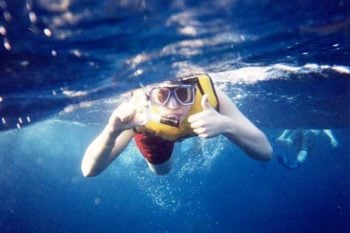Planning a Snorkeling Trip
 You’re about to embark on the trip of a lifetime, or maybe the permanent relocation you’ve dreamed of for years, and you can’t wait to indulge in one of travel’s greatest pleasures: exploring the coastlines and coves of your new home away from home. It’s time to go snorkeling!
You’re about to embark on the trip of a lifetime, or maybe the permanent relocation you’ve dreamed of for years, and you can’t wait to indulge in one of travel’s greatest pleasures: exploring the coastlines and coves of your new home away from home. It’s time to go snorkeling!
Snorkeling may just be the perfect travel adventure activity. Young and old alike can enjoy snorkeling on every continent – even Antarctica – and in every imaginable body of water, including lakes, rivers, bogs, wetlands, and, of course, oceans. Here’s how to make the most of the experience and stay safe while doing so.
Preparing for Your Trip
Do your research. Not all beautiful beaches feature great snorkeling and sometimes the best underwater vistas are found by lackluster shores. Know the best times of day for viewings and read guidebooks to see what spots are frequented by locals versus those overrun by tourists.
Related: How to Plan an International Trip
Listen to a Lifeguard
Respect the ocean and listen to the lifeguards. Even calm waters can hide unexpected currents and swells. Adhere to posted notices and when in doubt, follow the many, not the few. If most snorkelers are avoiding an area, it’s best to follow suit.
Go Snorkeling with a Friend
Never snorkel alone. Even confident swimmers will benefit from a buddy who can help adjust gear, point out great photo opps, and provide navigation over slippery rocks – not to mention someone who can call for help should you run into trouble.
Keep Your Distance
Like all nature activities, take nothing but photographs and leave nothing but footprints – er, make that waves. Marine animals are to be admired, not touched. Even the most charming of sea creatures can bite or sting and respecting their space ensures a better snorkeling experience for all involved (and, in some jurisdiction, touching endangered animals can lead to stiff fines).
Take Care of Your Health
Make sure your travel insurance is up to date. Coral scrapes and embedded sea urchin spines can cause horrible infections, while jellyfish stings and sunburns bring discomfort and even pain. And if you’re prone to seasickness, check with your doctor before departure. The vertigo-inclined may well find themselves woozy thanks to a disconnect between the calm underwater world they see through their mask and the undetected swaying their body experiences on the surface. A physician can recommend a preventative medication to keep your stomach calm and your head steady.
Choose Snorkeling Gear with Care
Be picky with your gear. Comfortable, well fitting gear can make or break any sporting activity and snorkeling is no different. Flippers should feel like a natural extension of your feet, flexible but secure, without worry that they’ll slip off. Masks should be snug but still allow you to easily move your head. If you’re heading out on a tour program that includes basic gear, ask if they also provide anti-fog drops for the masks, life vests for uncertain swimmers, and complimentary sunscreen.
Savor the Moment
Finally, take the time to relax and enjoy yourself! There’s no bucket list here and no such thing as a bad viewing. Snorkeling is one of the easiest and most accessible adventure activities of all, giving people of all ages and swim abilities the chance to experience some of nature’s most spectacular scenery.
